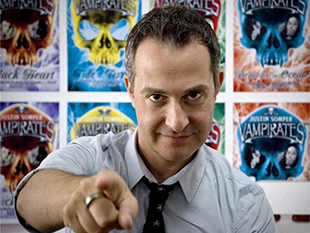This post comes to you thanks to my client and friend, Andy Dickenson. Andy has written and self-published his debut novel, The Last Days, a futuristic thriller and murder mystery featuring a vivid cast of comic book-inspired characters (you can read a recent review here). Andy is also a journalist at ITV/Meridian, as is evidenced by his pithy summary below.
Why Every Author Needs To Know Their Author Brand with Justin Stomper and Philip Norman


So who wants to be a brand?
No?
Well look away now because it seems you may have to be. In fact, you may be one already...
As the course notes to this session, Why Every Author Needs To Know Their Author Brand, suggested “branding” is not quite the dirty word in literary circles it used to be. Rather, publishers and readers have probably seen us (both authors and illustrators) as brands for some time now.
That’s perhaps a frightening prospect but one, now that we’re all tied in to social, if not traditional, media, we need to get our heads around – whether to exploit it, or stop ourselves becoming swamped by it.
With the huge changes in publishing over the past three years authors/illustrators, we were told, have more power now. We can publish our work ourselves. We can talk directly to our audience (if we can find them). But what do we say? How much information do we put out? How often, and where?
The key, Phillip Norman and Justin Somper suggest – both with impressive brands of their own to back them up – is consistency. Knowing what your (buzz word alert) “core message” is. How to refine it and articulate it. And, where necessary, adapt it.
To help in this exercise we were given examples of some of the biggest author brands around – Rick Riordan, Jilly Cooper, Dan Brown and Bill Bryson - and gradually managed to boil down the three central planks of their public personalities.
Some are restrained: Dan Brown, for example, even goes as far as wearing the same outfit for publicity photos. His message is one of the hard working professional, and little more.
Others far more fluid: Bill Bryson, for example, “more English than the English”, a social commentator, now, as well as a travel guide, his nuanced observations as applicable to science as they are to countryside campaigns.
And yet some are obvious. Jilly Cooper does raunchy, Rick Riordan does Greek myths. But both can introduce personal back stories. The Percy Jackson author speaks candidly of his son’s ADHD, giving him a reach beyond the Sunday supplements and into newspaper stories themselves.
All this then begged the question, how far would we go? How much would we make private or keep public? And, with all our Updates and Tweets, what are we saying about ourselves already?
What followed was a personal exercise to extract the three clear messages that define us and our books, followed with the chance to test them on others. For some, perhaps the more practiced professionals, this seemed easy – Celia Rees stepped forward. For others, myself included, this was hard but, I became convinced, necessary.
As the conference went on, the cogs of my mind slowly turning, I began to break down my own message:
- I write books about the end of the world – perhaps giving me some scope to publicly discuss the issues I fear threaten it?
- My focus is on teenage characters with extreme responsibilities – so maybe I can contribute a thought on the antecedents (in my case comic book heroes) that helped define them?
- And, behind it all, I wrestle with ideas of faith, destiny and fear – and would I be brave enough to enter that debate?
This may come across like a work in progress and, of course, it is. But it’s perhaps worthwhile to repeat the conclusion from the course’s handout to underline why, even as a rough sketch, it’s important:
“Your audience will decide what your brand is based on the information available to them. That is, the information you decide to put out there. This includes what you say at events or interviews, what you Tweet about, and how you dress. Your brand recognition will be far more effective if you control what details your audience has to choose from.”
In the flippant parlance so common in social media itself then, perhaps the core message here is: Think before you Tweet.
Andy Dickenson
http://www.thelastdays-online.co.uk/


